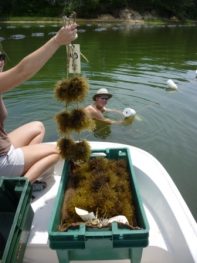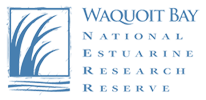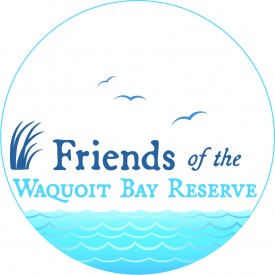Coupling sediment Fe(II) oxidation with denitrification and DNRA
Project Title: Coupling sediment Fe(II) oxidation with denitrification and DNRA
Date: 2019-2020
Principal Investigator(s): Claudia Mazur, Robinson Fulweiler
Affiliations: Boston University
Summary: Nitrogen is an essential nutrient for primary productivity in coastal systems, yet excess nitrogen loading from human activities such as fertilizer runoff and wastewater treatment discharge can lead to a series of negative consequences. These consequences include harmful algal blooms, low oxygen conditions and decreased biodiversity. To reduce these impacts, we aim to understand the environmental conditions that drive the pathways of nitrogen retention (dissimilatory nitrate reduction to ammonium or DNRA) and removal (denitrification) in estuaries. One environmental condition influencing these processes may be the presence of iron (Fe). The purpose of our research is to determine how iron oxidation rates alter the sediment microbial community composition and subsequently rates of nitrogen retention and removal costal sediments. We will collect sediment and porewater samples along a gradient of high to low concentrations of iron from the subterranean groundwater discharge located at the head Waquoit Bay. We will use these samples to (1) quantify seasonal rates of sediment iron oxidation, denitrification and DNRA, (2) determine how concentrations of iron and nitrate alter rates of denitrification and DNRA and (3) characterize the potentially active sediment microbial community. By understanding the factors that influence processes such as denitrification and DNRA, we can better predict the fate of nutrients and productivity in coastal sediments.
HOBO RX3000 Nutrient Monitoring
Project Title: HOBO RX3000 Nutrient Monitoring
Date: 7/2018-10/2018
Principal Investigator(s): Jacob Lacourse
Affiliations: Onset Computer – Director of Hardware Engineering
Summary: Nitrogen and phosphorous are essential nutrients for plants. Aquatic plants and algae rely on these nutrients for growth, allowing the plants to become food and habitats for other organisms. Too much of these nutrients, however, tips the scale of algal growth to a point which the ecosystem is not able to balance. The excess availability of nitrogen and phosphorous comes from anthropogenic sources and can cause algal blooms that inhibit oxygen availability to aquatic organisms, and especially to fish. The United States Environmental Protection Agency (USEPA) has identified nutrient pollution to be one of the largest and most expensive environmental issues affecting the United States and has initiated a challenge to manufacturers to produce a cost-effective method for monitoring nutrient pollution (specifically nitrates and phosphates). In response to this, and in recognition of our continued focus on protecting the environment around us, Onset Computer, manufacturers of the HOBO Data Loggers, has begun a project to monitor the nutrient levels in Waquoit Bay over several months.
Quantifying the biogenic silica content of primary producers in Waquoit Bay
Lead Investigator: Robinson W. “Wally” Fulweiler, Sarah Foster, PhD student, Mollie Yacano, undergraduate researcher
Affiliation: Boston University, Earth and Environment Department
Funding Source(s): Undergraduate Research Opportunities Program (UROP), Boston University
Experimental assessment of the macroalgae Ascophyllum nodosum and Fucus vesiculosus for monitoring N sources at different time-scales using stable isotope composition
Project Title: Experimental assessment of the macroalgae Ascophyllum nodosum and Fucus vesiculosus for monitoring N sources at different time-scales using stable isotope composition
Date: 2015
Principal Investigator(s): Viana, I. G., Bode, A., Bartholomew, M., & Valiela, I.
Abstract: Stable isotope composition of brown macroalgae has been widely used to monitor N loading during the last decades but some of the required assumptions when using them to detect anthropogenic inputs remain untested. In this study several experiments were run with two key species, A. nodosum and F. vesiculosus, to determine internal nitrogen isotope dynamics. Read full text…Journal of Experimental Marine Biology and Ecology, 466, 24-33. http://www.sciencedirect.com/science/article/pii/S0022098115000210
Sub-estuarine Groundwater Discharge (SGD), Dissolved Nutrients and the Production of Benthic Microalgae
PIs: Rachel Stanley, WHOI
Evan Howard, WHOI
Funding: WHOI
Multi-Cropping Shellfish and Macroalgae for Business and Bioextraction
 PI: Scott Lindell, Scientific Aquaculture Program, MBL. Funding: WHOI-Seagrant
PI: Scott Lindell, Scientific Aquaculture Program, MBL. Funding: WHOI-Seagrant
Description: Nutrient enrichment from septic systems is one of the most pressing coastal problems on Cape Cod. Towns are facing staggering costs for sewering and other solutions. This project aims to investigate whether a native seaweed, Gracilaria tikvahiae, can be co-farmed together with oysters to both soak up nutrients and produce a marketable crop.


